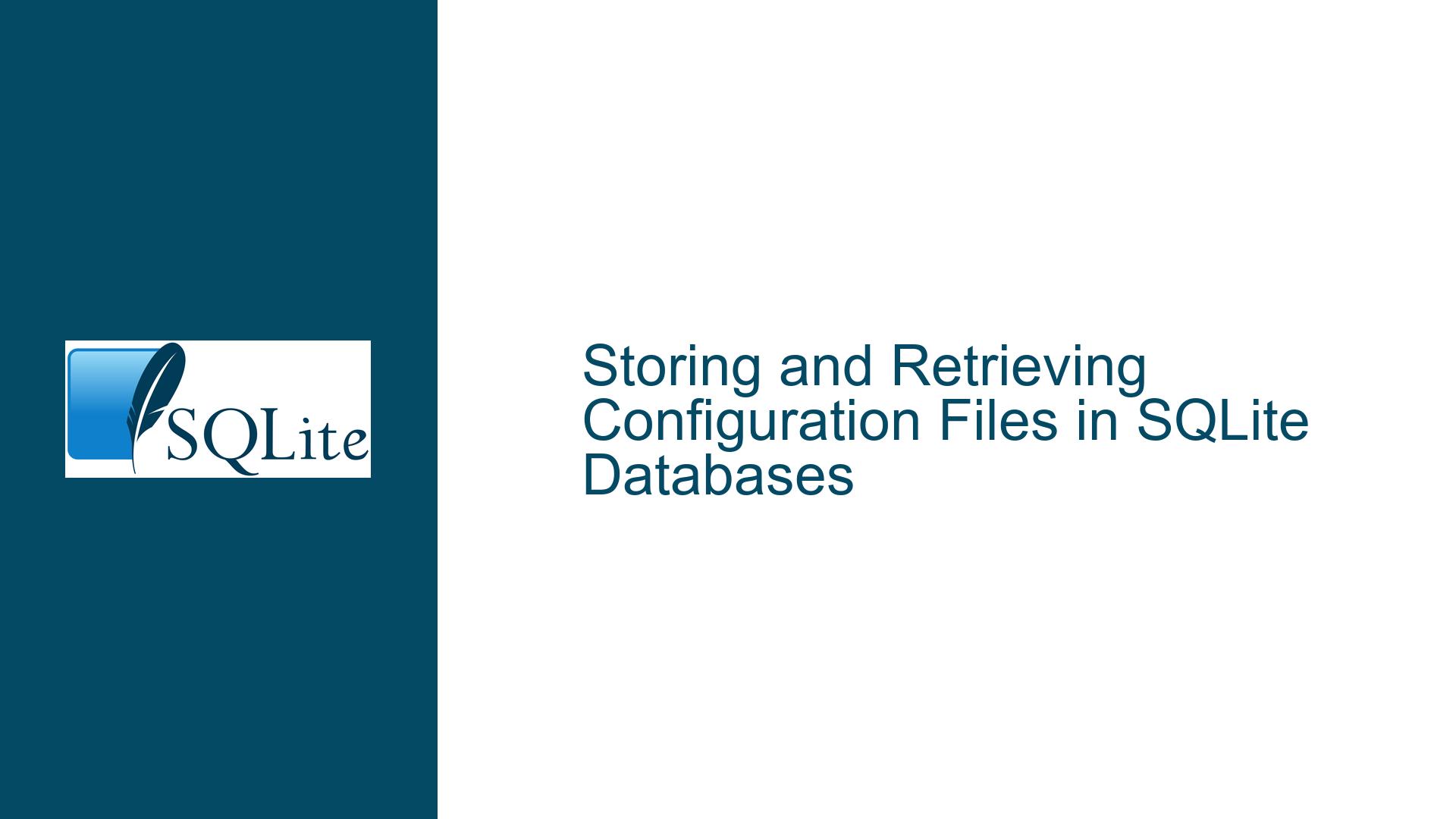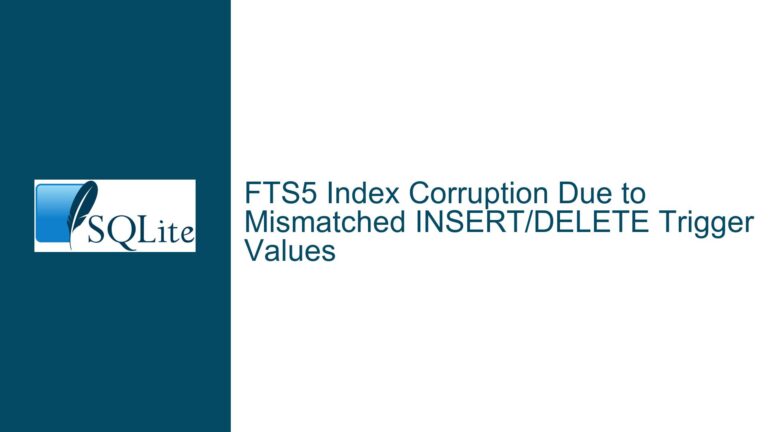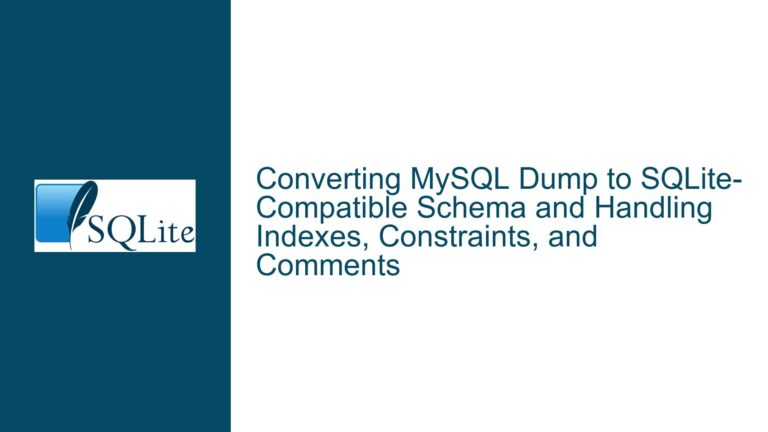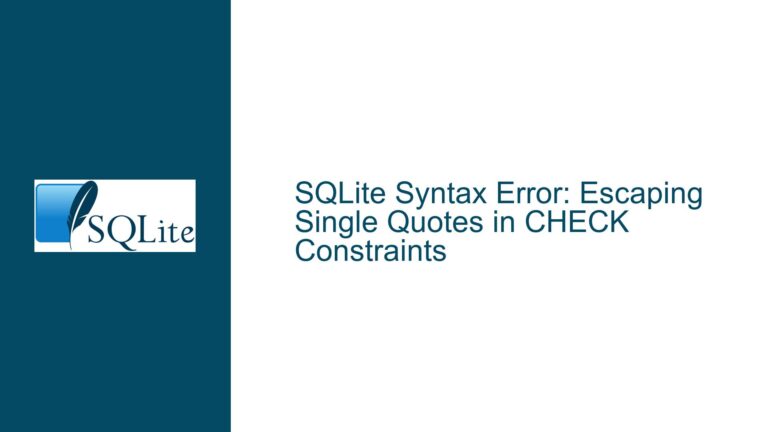Storing and Retrieving Configuration Files in SQLite Databases
Issue Overview: Saving and Loading Configuration Files in SQLite
When working with software applications, one common requirement is the ability to save and load configuration files. Configuration files typically store settings, preferences, and other parameters that dictate how the software operates. These files can range from simple key-value pairs to more complex hierarchical structures. SQLite, being a lightweight, serverless, and self-contained database engine, is often a suitable choice for managing such configurations due to its portability, ease of use, and robust performance.
The core issue revolves around how to effectively store and retrieve configuration files within an SQLite database. This involves understanding the best practices for structuring the database schema, deciding on the appropriate data types, and implementing efficient queries to insert and retrieve configuration data. Additionally, considerations must be made for version control, data integrity, and performance optimization, especially when dealing with large or frequently updated configuration files.
One of the primary challenges is determining the most suitable method for storing configuration data. While SQLite provides various options, such as storing files directly as BLOBs (Binary Large Objects) or using a key-value store, each approach has its own set of trade-offs. For instance, storing files as BLOBs may be straightforward but could lead to inefficiencies when dealing with large files or frequent updates. On the other hand, a key-value store might offer more flexibility and better performance for certain types of configurations but may require a more complex schema design.
Another aspect to consider is the integration of version control mechanisms. In scenarios where configuration files undergo frequent changes, it may be beneficial to implement a versioning system that tracks modifications over time. This can be particularly useful for debugging, auditing, and rollback purposes. SQLite itself does not provide built-in version control, but it can be achieved through careful schema design and application logic.
Possible Causes: Challenges in Storing and Retrieving Configuration Files
The challenges associated with saving and loading configuration files in SQLite databases can be attributed to several factors. One of the primary causes is the lack of a standardized approach for handling configuration data. Different applications have varying requirements, and what works well for one use case may not be suitable for another. This variability can lead to confusion and suboptimal implementations.
Another contributing factor is the complexity of the configuration data itself. Configuration files can range from simple text files with a few key-value pairs to complex XML or JSON documents with nested structures. The complexity of the data directly impacts the design of the database schema and the queries used to interact with it. For example, storing a JSON configuration file as a single BLOB may be simple, but querying specific values within the JSON structure would require additional processing, such as parsing the JSON within the application code.
Performance considerations also play a significant role in the challenges faced. SQLite is designed to be lightweight and efficient, but improper schema design or query optimization can lead to performance bottlenecks, especially when dealing with large configuration files or high-frequency updates. For instance, repeatedly updating a large BLOB can result in fragmentation and increased I/O overhead, negatively impacting performance.
Data integrity is another critical factor. Ensuring that the configuration data remains consistent and accurate is paramount, particularly in environments where multiple processes or threads may access the database concurrently. SQLite provides mechanisms such as transactions and locking to maintain data integrity, but these must be used correctly to avoid issues such as deadlocks or data corruption.
Lastly, the lack of built-in version control in SQLite can be a limitation for applications that require tracking changes to configuration files over time. While it is possible to implement versioning manually, this adds complexity to the schema and application logic, potentially introducing new challenges and sources of errors.
Troubleshooting Steps, Solutions & Fixes: Best Practices for Managing Configuration Files in SQLite
To effectively manage configuration files in SQLite, it is essential to follow best practices that address the challenges outlined above. These practices encompass schema design, data storage methods, query optimization, and version control.
Schema Design and Data Storage Methods
The first step in managing configuration files is to design an appropriate schema that aligns with the structure and complexity of the configuration data. For simple key-value pairs, a straightforward table with columns for the key and value may suffice. For example:
CREATE TABLE Config (
key TEXT PRIMARY KEY,
value TEXT
);
This schema is suitable for storing flat key-value configurations, where each key is unique and maps to a single value. However, for more complex configurations, such as those involving nested structures or multiple values per key, a more sophisticated schema may be required. One approach is to use a table with additional columns to represent different levels of hierarchy or to store the configuration data in a structured format like JSON or XML within a single column.
When dealing with large or binary configuration files, storing the data as a BLOB may be necessary. However, this approach should be used judiciously, as it can lead to performance issues if the files are large or frequently updated. In such cases, it may be beneficial to store the files externally and only keep references (e.g., file paths or URLs) in the database. Alternatively, consider using SQLite’s sqlar extension, which allows for efficient storage and retrieval of files within an SQLite archive.
Query Optimization and Performance Considerations
Optimizing queries is crucial for maintaining performance, especially when dealing with large or frequently accessed configuration data. One common optimization technique is to use indexes on frequently queried columns. For example, if the key column in the Config table is often used in WHERE clauses, creating an index on this column can significantly improve query performance:
CREATE INDEX idx_config_key ON Config(key);
Another important consideration is minimizing the number of database operations. For instance, instead of executing multiple INSERT or UPDATE statements for individual key-value pairs, batch operations can be used to reduce overhead. SQLite supports transactions, which can be used to group multiple operations into a single atomic unit, improving both performance and data integrity:
BEGIN TRANSACTION;
INSERT INTO Config (key, value) VALUES ('key1', 'value1');
INSERT INTO Config (key, value) VALUES ('key2', 'value2');
COMMIT;
When dealing with large BLOBs, it is advisable to avoid frequent updates, as these can lead to fragmentation and increased I/O overhead. Instead, consider using a write-once, read-many approach, where the BLOB is written once and subsequently read multiple times. If updates are necessary, consider using a versioning system where each version of the BLOB is stored as a separate row, allowing for efficient retrieval of specific versions without modifying existing data.
Implementing Version Control for Configuration Files
For applications that require version control of configuration files, implementing a versioning system within the SQLite database is essential. One approach is to extend the schema to include version information. For example, the Config table can be modified to include a version column:
CREATE TABLE Config (
key TEXT,
value TEXT,
version INTEGER,
PRIMARY KEY (key, version)
);
In this schema, each key can have multiple versions, with the version column indicating the version number. To retrieve the latest version of a configuration, a query can be used to select the maximum version for each key:
SELECT key, value
FROM Config
WHERE version = (SELECT MAX(version) FROM Config WHERE key = 'key1');
This approach allows for efficient tracking of changes over time and provides the ability to roll back to previous versions if necessary. Additionally, it is possible to implement more sophisticated versioning strategies, such as branching or tagging, by extending the schema further to include additional metadata (e.g., branch names, tags, timestamps).
Ensuring Data Integrity and Concurrency Control
Maintaining data integrity is critical when multiple processes or threads access the SQLite database concurrently. SQLite provides several mechanisms to ensure data consistency, including transactions, locks, and the WAL (Write-Ahead Logging) mode. Transactions allow multiple operations to be grouped into a single atomic unit, ensuring that either all operations are committed or none are:
BEGIN TRANSACTION;
-- Perform multiple operations
COMMIT;
In scenarios where concurrent access is common, enabling the WAL mode can improve performance and reduce contention:
PRAGMA journal_mode=WAL;
The WAL mode allows readers to continue accessing the database while a write operation is in progress, reducing the likelihood of conflicts. However, it is important to note that WAL mode may not be suitable for all use cases, particularly those involving network file systems or certain types of hardware.
Conclusion
Storing and retrieving configuration files in SQLite databases requires careful consideration of schema design, data storage methods, query optimization, and version control. By following best practices and leveraging SQLite’s features, it is possible to create a robust and efficient system for managing configuration data. Whether dealing with simple key-value pairs or complex hierarchical structures, the key is to tailor the approach to the specific requirements of the application, ensuring both performance and data integrity are maintained.






